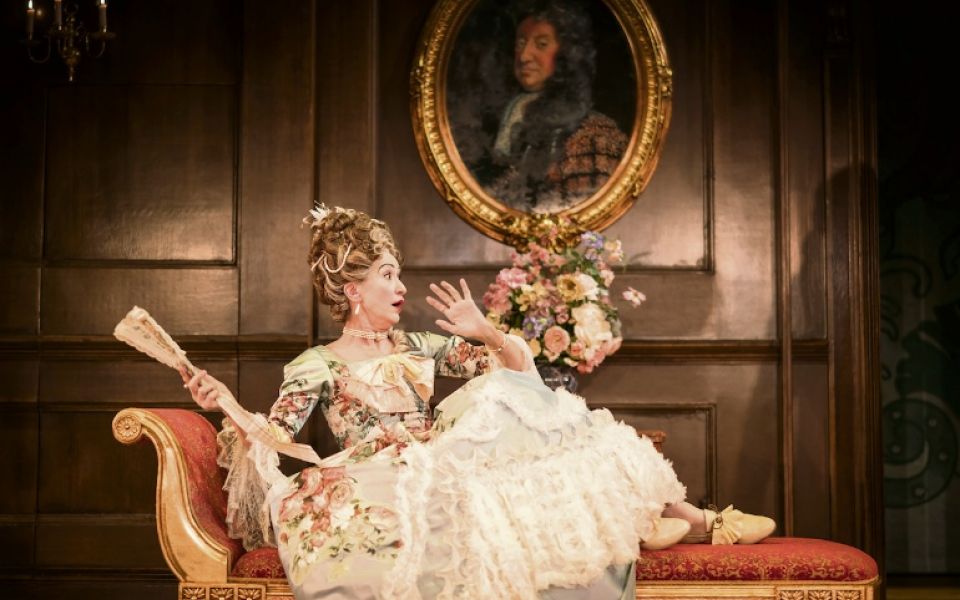There’s no limit to how much bad acting you can do with a fan, if you’re in a folderol frame of mind. Point it for emphasis, snap it shut in high dudgeon. Make peekaboo eyes over the top or flutter it for the full coquette. It can easily become camp. Anyone who doesn’t enjoy costume drama onstage will be no fan of the fan.
But it doesn’t have to be this way. Most of the props that sashay into this series are proper little scene stealers. Whether a sociopathic doll or recalcitrant ironing board, they pull focus from their human co-stars and make it all about them. Not so the fans in James Macdonald’s superlatively lucid production of The Way of the World at London’s Donmar – they’re as committed ensemble players as any of the quality actors around them.
Revivals of Restoration comedy – that awkward late 17th-century genre of fops and fortune-hunters in flounces – often unleash an embarrassment of fanwork. Working from the misbegotten assumption that a) the play has to be superfun and that b) it actually isn’t, directors break out the clack and flutter, giving their female actors a lot of faff with accessories.
This was clearly the case in the original productions. Restoration writers had an eye for fan flirtation. In The Spectator, Joseph Addison parsed ‘the fluttering of the fan,’ distinguishing between different kinds of flutter: angry, modest, timorous, confused, merry and amorous.’ Harriet, the heroine in Etherege’s The Man of Mode, gets a fan tutorial: ‘clap your fan then in both hands, snatch it to your mouth, smile, and with a lively motion fling your body a little forward.’ And, in the same play, the horndog hero assesses his success by notching how many women he has provoked to break their fan in the grip of strong emotion.
The Donmar’s cast have certainly taken their fan classes, as described in an invaluable education pack (composer Max Pappenheim led the cohort – prompting assistant director Jo Tyabji to quote Simone de Beauvoir: ‘one is not born a woman, but becomes one’). Yes, Anna Fleischle’s sumptuous frocks and frock coats are fully accessorised. Lady Wishfort (Haydn Gwynne, pictured above by Johan Persson), who hosts the tangled plot’s intrigues, has botanical embroidery on her fan. Others are the thrillingly deep colours of the dresses. And yes, people periodically point and snap them, put up a diversionary flap if caught off guard.
What’s so funny about that?
But none of this is panto-style, because here’s the thing. Macdonald doesn’t direct Congreve’s 1700 drama as a comedy, but simply as – a play. It reminds you how labels can warp our responses. Tragedies are set in the past, or far away, and end in death. Comedies are set in the here and now end in marriage. What’s so funny about that? Macdonald (best known for clearsighted takes on new plays by Caryl Churchill and Annie Baker) doesn’t suppress the chortles, but makes everything as clear as it can be. Congreve’s tight nest of characters are tangled up in family and finance. In most plays, you can define a character as predominantly ‘the wife’ or ‘the father.’ Here, Arabella Fainall – horribly shafted by the plot – is alternately daughter, wife, ex, employer, friend and frenemy, depending on who she’s speaking to.
As with the fans, so with the frolics: it’s not an especially sexy production, and that’s a bonus. Restoration revivals can be sticky with innuendo, but here everyone wants to get not just laid but (more difficult, this) loved. Lady Wishfort, despite the harsh sneer of her name, yearns for grand romance, making her a mark for a plausible con. Mirabell’s women are repelled, dumped, pursued – but (slightly bafflingly) still they love him. Even Petulant, the local lout, pays women to call at him so that he can appear a player in the amorous economy.
Love raises the stakes, because relationships then pivot round who you can trust and what you can afford. The cast met economic historian Amy Louise Erickson (who, pleasingly, has written a paper on fans and Fanny Burney), and you sense that they’ve thought very precisely about everyone’s bank accounts. Less flush than they pretend, mostly – no wonder the coffee house massive end up travelling with a wealthier chum, or that Millamant guards her six grand so charily. The play’s villains, Fainall and Marwood, are only a couple of rungs about penury, in my reckoning – if cut loose they’ll sink. No wonder they snarl.
This is real talk. True misery and loneliness stalk the play – fears more pressing than the fragile relationships that hope to paper over the cracks. No amount of frisky fanwork can compensate for being married off to an abusive crook, or watching the person you long for pursue someone else. You’d bet that most of the characters will end up miserable – I’m not certain that the central couple, Millamant and Mirabell, won’t be among them. Flutter cannot make that scenario more cheerful.
Follow David on Twitter: @mrdavidjays


Leave a Reply